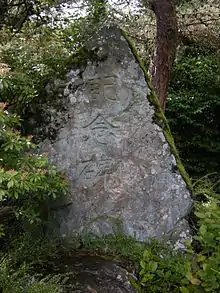Fujitaro Kubota
Fujitaro Kubota (1879–1973) was a Japanese-born American gardener and philanthropist.[1]
Kubota was among the Issei emigrants from Japan who made new lives for themselves in the United States. When he first arrived, he worked on the railroad. By 1922, he was able to start his own gardening business in Seattle. In 1927, he began work on a small garden as a hobby; and the task would assume an important role in the rest of his life and that of his children and grandchildren.[2]
Kubota and his family were interned at Camp Minidoka in Idaho during the early days of World War II. His Seattle-born son Tom (1917–2004) would meet his wife at Minidoka.[2]
Honors

In the year before his death, the Japanese Government honored this lifelong gardener by presenting him with the Order of the Sacred Treasure "for his achievements in his adopted country, for introducing and building respect for Japanese Gardening."[1] The formal decoration badge is a Maltese cross in gilt and silver which was produced by the Japan Mint.[3]
The public garden which bears Kubota's name is no less significant as a monument to Kubota's life.
See also
- Kubota Garden, Rainier Beach neighborhood in south Seattle
- Bloedel Reserve, Bainbridge Island
Notes
- Honor awarded 1972 -- Appelo, Tim. "University of the Future: The physical transformation into a premier independent university," Archived 2009-03-08 at the Wayback Machine Seattle University Magazine. Summer 2008.
- Davila, Forangela. "Gardener Tom Kubota, 87, leaves serene legacy," Seattle Times. August 18, 2004.
- Japan Mint: Production of Orders & Medals Archived 2013-01-05 at the Wayback Machine.
References
- Itō, Kazuo. (1973). Issei: A History of Japanese Immigrants in North America. Seattle: Japanese Community Service. OCLC 3698919
- Joyce, Alice. (2006). Gardenwalks in the Pacific Northwest: Beautiful Gardens Along the Coast from Oregon to British Columbia. Guilford, Connecticut: Globe Pequot. ISBN 978-0-7627-3818-2; OCLC 62302537
